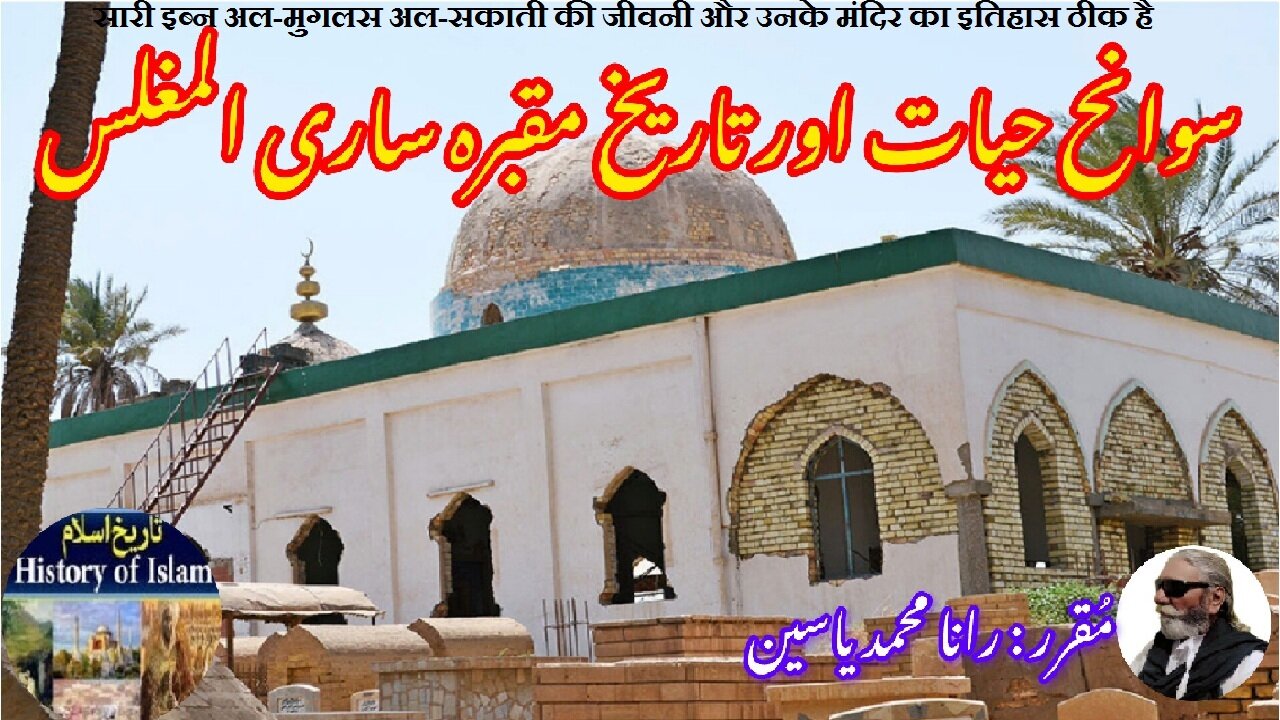Premium Only Content

Sari Ibn Al-Mughlas Al-Saqati and shrine ساری ابن المغلس السقطی کی سوانح حیات اور مزار کی تاریخ
@islamichistory813 #sufisaint #cultural #heritage #biography #islamic #mysticism #islamic #philosophy #shrine #historical #figures
Biography of Sari ibn al-Mughallis al-Saqati and the history of his shrine
Dekhti Aankhooon aur sountay kaanoon ko Asslamoalaikum, sisters, brothers friends and elders, in informative series videos of Islamic ascolars, sufisaints, cultural heritages, islamic philosophys, islamic mysticisms and historical figures. today we are describing biography of Sari ibn al-Mughallis al-Saqati and the history of his shrine.
Sari ibn al-Mughallis al-Saqati, born in **155 AH (772 CE)** in the **Karkh district of Baghdad**, is recognized as one of the pioneering figures in early Islamic mysticism, or **Sufism (Tasawwuf)**. As one of the foremost disciples of the great Sufi master **Maruf Karkhi**, Sari al-Saqati played a central role in laying the intellectual and spiritual foundations of Sufism in Baghdad, which would become one of the major centers of Islamic spirituality in the classical Islamic world. His profound influence on later generations of Sufis, including his most famous student and nephew **Junayd of Baghdad**, has earned him a distinguished place among the early Muslim saints.
Sari al-Saqati grew up in a humble household in Baghdad, a city that was, during his time, not only the political heart of the Abbasid Caliphate but also a flourishing center of Islamic scholarship, theology, and mysticism. His family was engaged in the business of selling second-hand goods and scrap items, hence the name **“Saqati”**, which refers to someone involved in such trade. Sari himself initially followed this profession and maintained a shop in Baghdad, leading a simple life. Yet, from a young age, he showed an inclination toward religious learning and spiritual development.
In the early part of his life, Sari undertook journeys, including to **Mecca**, in pursuit of **hadith** (sayings and traditions of the Prophet Muhammad, peace be upon him), collecting knowledge from various scholars. His engagement with traditional Islamic sciences laid a firm foundation for his later role as a Sufi master who would combine outward knowledge ('ilm) with inward realization (ma'rifah).
A significant turning point in Sari al-Saqati’s life occurred through his interactions with **Maruf Karkhi**, a legendary Sufi known for his piety and asceticism. According to traditional accounts, one day Maruf Karkhi visited Sari's shop accompanied by an orphan child and requested that Sari clothe the child. Sari complied generously, and in response, Maruf Karkhi offered a heartfelt prayer for him. This incident, according to hagiographic sources, sparked a deep spiritual transformation in Sari, who thereafter dedicated himself fully to the Sufi path under Maruf’s guidance. He was also influenced by other ascetic figures such as **Habib al-Ajami**, known for his sincerity and devotion.
Sari al-Saqati became known not just for his ascetic lifestyle but also for his deep **theological insight**, **wisdom**, and ability to articulate mystical truths. He was among the first to **systematically express Sufi teachings**, thereby making him one of the early codifiers of Sufi thought. His teachings emphasized the importance of sincerity (ikhlas), remembrance of God (dhikr), inner purification, and divine love. His contributions are especially important because they helped transition Sufism from a loosely connected set of ascetic practices into a more defined spiritual methodology within Islam.
Sari’s circle of disciples included some of the most celebrated figures in Islamic spirituality, most notably **Junayd of Baghdad**, his **nephew and spiritual successor**, who would later be recognized as one of the greatest early Sufi theorists. Sari's friendship with **Bishr al-Hafi**, another noted ascetic of the time, further illustrates the strong network of early Sufi masters who emphasized humility, devotion, and spiritual awakening.
Sari ibn al-Mughallis al-Saqati passed away in **251 AH (865 CE)** in his birthplace, **Baghdad**, the city that had nurtured his spiritual journey. His death marked the end of an era in which Sufism was still in its formative phase, and his legacy would be carried forward by his students and the generations of Sufi thinkers and practitioners that followed.
His **shrine is located in Baghdad**, where it has remained a place of reverence for those following the Sufi path. The exact details about the initial construction of the shrine are sparse due to the passage of time and historical upheavals in Baghdad, but it is believed that **his tomb was first marked and maintained by his followers**, particularly the disciples of **Junayd**, who held Sari in the highest esteem. Over the centuries, as reverence for early Sufi saints grew, efforts were made by Sufi orders and local devotees to preserve and restore his final resting place.
Despite the many historical events that have affected Baghdad over the centuries, Sari al-Saqati's shrine has continued to attract **visitors, scholars, and Sufi pilgrims**, who seek inspiration from the life of a man who embodied the spiritual ideals of humility, love of God, and inner purification. His role as both a transmitter of traditional Islamic knowledge and a pioneer of structured Sufi thought cements his place among the **foundational figures of Islamic mysticism**.
Today, Sari al-Saqati is remembered not just for his personal piety but for his intellectual and spiritual contributions that helped define what would become classical Sufism. His legacy lives on through the writings and teachings of his disciples and the many spiritual seekers who continue to follow the path he helped illuminate.
With this, we seek your permission until tomorrow, tomorrow we will describe the biography of Sultan Bahu and the history of his Shrine.
Allah Hafiz
==============================
-
 7:53
7:53
ISLAMIC HISTORY
1 day agoBiography of Al-Abbas ibn Said al-Jawhari سیرت العباس بن سعید الجوہری
8 -
 1:14:58
1:14:58
vivafrei
4 hours agoHe Was There! Charlie Kirk Assassination Analysis & Conspiracy Debunking w/ Andrew Piskadlo!
19.8K17 -
 LIVE
LIVE
Dr Disrespect
5 hours ago🔴LIVE - DR DISRESPECT - BLACK OPS 7 MULTIPLAYER GAMEPLAY - NEW!
1,715 watching -
 LIVE
LIVE
Dr. Drew
4 hours agoFL First Lady Casey DeSantis: Florida Ending ALL Vaccine Mandates, Including For Schools w/ FL Surgeon General Dr. Joseph Ladapo & Tom Renz – Ask Dr. Drew
1,957 watching -
 1:05:57
1:05:57
Russell Brand
3 hours agoPfizer Agrees $70 Million Deal With Trump As Study Links Covid Vax to CANCER!! - SF644
61K55 -
 48:25
48:25
JULIE GREEN MINISTRIES
1 hour agoLIVE WITH JULE, ERIC TRUMP AND CLAY CLARK
7.7K36 -
 1:04:57
1:04:57
The Quartering
4 hours agoTrump Tricks Democrats Again, Cheerleader Monster, Abortion Clinics Shutdown & More
66.1K18 -
 7:59
7:59
Dr. Nick Zyrowski
1 year agoHow Much Vitamin D Should I Take
2622 -
 1:23:00
1:23:00
Brandon Gentile
1 day agoJames Lavish: The Red Flag Event Sends Us To $1M Bitcoin & $20K Gold
38 -
 1:23:46
1:23:46
Sean Unpaved
4 hours agoOctober Blitz: Wild Card Game 3s, CFB Coaching Chaos, & TNF Fireworks
27.1K4
